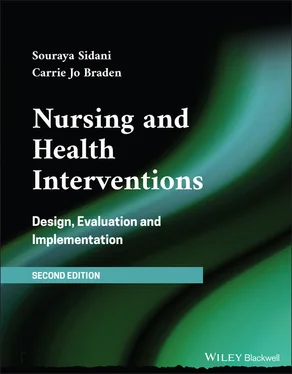Analysis of available data has the advantages of: enhanced generalizability of the findings because the data were obtained from large, representative samples; ability to conduct the analysis on the client population and/or context of interest without losing statistical power; low reactivity (e.g. low social desirability) of the data collected routinely in practice (Baur, 2019); and opportunity to examine the contribution of a wide range of determinants.
The drawbacks of this approach are attributable to the quality of the data. For instance, single items are often used to measure the concepts potentially threatening construct validity. The procedure for data collection may not be standardized or applied consistently across data collectors, which has the potential for incomplete or missing information and for introducing biases (Baur, 2019).
In summary, the empirical approach is an effective and efficient (if data are already collected) way of generating an understanding of the health problem. Literature reviews and analysis of available data are more efficient, whereas the conduct of primary studies is resource and time intensive. However, the available evidence may not be relevant and applicable to the specific client population and context of interest. The experiential approach is useful in this case (Baker et al., 2018).
3.3.3 Experiential Approach
3.3.3.1 Overview
The experiential approach relies on input from the target client population to elicit the implicit theory or construction of the health problem requiring intervention. Exploring the target client population's perspective on how the problem is experienced in daily life and on the most important factors contributing to the problem is critical for designing interventions that are relevant, appropriate, and potentially effective in addressing the problem as actually experienced (Clark, 2015; Huntink et al., 2014; Leask et al., 2019; O'Brien et al., 2016; Wight et al., 2016; Yardley et al., 2015). The experiential approach is consistent with the principles of public or client engagement in research and in co‐designing services, and with the collaborative participatory approach to research (Greenlagh et al., 2016). The highlight of this approach is that researchers work closely with members of the target client population to uncover the population's view of the health problem.
The experiential approach entails holding meetings with members of the target client population to formulate the population's perception of the health problem, its indicators, determinants, and consequences. Although the meetings can be scheduled with individual members (based on their comfort and preference), holding group sessions offers more advantages (Hawkins et al., 2017; O'Brien et al., 2016). Through group discussion, the members have the opportunity to exchange ideas; respond to each other's comments; question, clarify, elaborate, and explain points; and reach agreement that captures collective, in‐depth, and comprehensive knowledge of the health problem (Sidani et al., 2017). Further, the group interaction promotes open and honest discussion of the problem, and prevents members from giving socially desirable and potentially misleading information. This, in turn, increases the likelihood of gaining collective knowledge of the problem that transcends individual idiosyncrasies and accurately captures the target population's perspective (Vogt et al., 2004). Participants in the group sessions are selected to represent a broad range of those who experience the problem, thereby ensuring that a variety of viewpoints are accounted for when describing the target client population's perspective. The number of participants in each group session should not exceed 12, to enable active and meaningful participation by all members. Multiple sessions may be held to accommodate participants representing different subgroups of the population (defined in terms of sociodemographic and health characteristics).
The group discussion should be carefully planned and executed in order to capture the target client population's conceptualization or construction of the health problem. Two procedures have been used to attain this goal, and are briefly reviewed here, as applied to gaining an understanding of the problem: concept mapping (Trochim, 1989; O'Brien et al., 2016; Vijn et al., 2018) and the first step of the integrated cultural adaptation strategy (Sidani et al., 2017).
3.3.3.2 Concept Mapping
Overview
Concept mapping is a structured process aimed at articulating thoughts or ideas related to complex phenomena or situations, and the relationships among them (Trochim, 1989). It results in a process map that delineates the inter‐relationships among the health problem and determinants, as perceived by a client population in a particular setting (Ball et al., 2017; Hesselink et al., 2014).
The concept mapping process integrates a mix of quantitative and qualitative methods for data collection and analysis. It consists of the following steps described by Trochim and colleagues (Burke et al., 2005; Trochim & Kane, 2005).
Step 1 – Preparation . In this planning step, decisions are made on the selection of participants (as mentioned previously) and the focal questions to guide the group discussion. These questions focus on eliciting participants' experience of the problem; view of its indicators and determinants; input on the relative importance of the determinants; and pathways linking the determinants and the problem. Additional questions are generated to prompt for clarification of ideas or words (e.g. What do you mean?), for delineation of pathways (e.g. Can you explain how these factors are related? Which occurred first and brought/led to the other?), and for reaching agreement on points of discussion (e.g. Does this reflect your thoughts?).
Step 2 – Generation of statements . In this step, selected participants are invited to attend a group session. The group moderator poses the questions prepared in Step 1, requests participants to generate statements that reflect their ideas or thoughts related to how they experience the problem with a special attention to its indicators (e.g. what changes in their condition are considered as indicative of the presence of the problem); what factors contribute to the occurrence, severity, or maintenance of the problem (e.g. What happened that led to the problem or what brought this problem?); and what are the consequences of the problem (e.g. How did the problem affect you?). The moderator and an assistant record the participants' responses on resources (e.g. projected computer screen, board, flipchart) visible to all group members. The responses are recorded verbatim in the form of statements as expressed by the participants. Once all statements are documented, the moderator engages the group in a review of the statements to identify duplicates, to recognize irrelevant ones, and to confirm a final list of statements about the presenting problem. The investigators review the transcript of the group session to verify that the generated list of statements accurately and comprehensively reflects the discussion. When several group sessions are held, the investigators consolidate the statements obtained in each session into a final list that consists of an exhaustive nonoverlapping account of all ideas or thoughts about the problem expressed by participants.
Step 3 – Structuring of statements . The goal of this step is to gain an understanding of the inter‐relationships among the ideas or thoughts generated in Step 2 that depict the target population's conceptualization of the problem. This is accomplished by having participants sort the statements into piles and rate the importance of statements in reflecting the problem. The sorting exercise is done individually by each participant. Each statement is printed on a card. Each participant is given the cards for all statements and instructed to put the cards into piles where each pile contains statements representing similar ideas, as perceived by the individual. No specific directions are given to do the sorting; rather, participants are given the freedom to arrange the statements in a way that is meaningful to them. However, they are requested to place each statement into one pile only, and not to put all statements into one pile. There is no restriction on the number of piles that can be generated. The data obtained with the sorting exercise are entered into a database for analysis. The database consists of a similarity matrix. The rows and columns of the matrix represent the statements, and the data in the cells represent the number of participants who place the pair of statements into the same pile. The similarity matrix is then subjected to multivariate analysis using multidimensional scaling technique and hierarchical cluster analysis. The analysis produces a map that locates nonoverlapping clusters of statements reflecting similar ideas (Trochim & Kane, 2005). In addition to sorting, the participants are asked to rate each statement in terms of its importance or relevance to the problem, on a five‐point rating scale. These data are also entered in a database and analyzed descriptively. The Concept System software can integrate the importance rating with the sorting data to indicate clusters of statements with varying levels of importance (Burke et al., 2005). The map is presented to the participants for discussion.
Читать дальше












